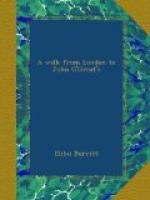The rain continued in showers, and I feared I should be unable to reach Inverness to spend the Sabbath. There was a cattle fair at the inn, and a considerable number of farmers and dealers came together notwithstanding the weather. Indeed, there were nearly as many men and boys as animals on the ground. A score or more had come in, each leading or driving a single cow or calf. The cattle generally were evidently of the Gaelic origin and antecedents— little, chubby, scraggy creatures, of all colors, but mostly black, with wide-branching horns longer than their fore-legs. Their hair is long and as coarse as a polar seal’s, and they look as if they knew no more of housing against snow, rain and wintry winds, or of a littered bed, than the buffaloes beyond the upper waters of the Missouri. One would be inclined to think they had lived from calf-hood on nothing but heather or gorse, and that the prickly fodder had penetrated through their hides and covered them with a growth midway between hair and bristles. They will not average over 350 lbs. when dressed; still they seem to hold their own among other breeds which have attracted so much attention. This is probably because they can browse out a living where the Durham and Devon would starve.
The sheep in this region are chiefly the old Scotch breed, with curling horns and crocked faces and legs, such as are represented in old pictures. The black seems to be spattered upon them, and looks as if the heather would rub it off. The wool is long and coarse, giving them a goat-like appearance. They seem to predominate over any other breed in this part of Scotland, yet not necessarily nor advantageously. A large sheep farmer from England was staying at the inn, with whom I had much conversation on the subject. He said the Cheviots were equally adapted to the Highlands, and thought they would ultimately supplant the black faces. Although he lived in Northumberland, full two hundred miles to the south, he had rented a large sheep-walk, or mountain farm, in the Western Highlands, and had come to this section to buy or hire another tract. He kept about 4,000 sheep, and intended to introduce the Cheviots upon these Scotch holdings, as their bodies were much heavier and their wool worth nearly double that of the old black-faced breed. Sheep are the principal source of wealth in the whole of the North and West of Scotland. I was told that sometimes a flock of 20,000 is owned by one man. The lands on which they are pastured will not rent above one or two English shillings per acre; and a flock even of 1,000 requires a vast range, as may be indicated by the reply of a Scotch farmer to an English one, on being asked by the latter, “How many sheep do you allow to the acre?” “Ah, mon,” was the answer, “that’s nae the way we count in the Highlands; it’s how monie acres to the sheep.”




